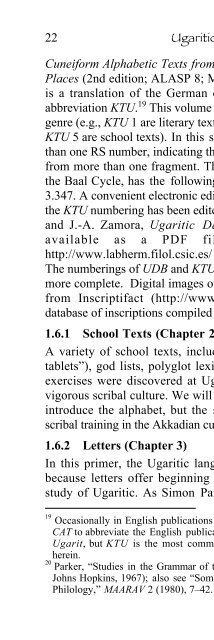A Primer on Ugaritic: Language, Culture, and Literature - enenuru
A Primer on Ugaritic: Language, Culture, and Literature - enenuru
A Primer on Ugaritic: Language, Culture, and Literature - enenuru
Create successful ePaper yourself
Turn your PDF publications into a flip-book with our unique Google optimized e-Paper software.
22<br />
<strong>Ugaritic</strong> <str<strong>on</strong>g>Primer</str<strong>on</strong>g><br />
Cuneiform Alphabetic Texts from Ugarit, Ras Ibn Hani <strong>and</strong> Other<br />
Places (2nd editi<strong>on</strong>; ALASP 8; Münster: UgaritVerlag, 1995); this<br />
is a translati<strong>on</strong> of the German original from which it gets the<br />
abbreviati<strong>on</strong> KTU. 19 This volume categorizes the texts according to<br />
genre (e.g., KTU 1 are literary texts, KTU 4 are administrative texts,<br />
KTU 5 are school texts). In this system, some texts can have more<br />
than <strong>on</strong>e RS number, indicating that the text has been rec<strong>on</strong>structed<br />
from more than <strong>on</strong>e fragment. Thus, KTU 1.4, which is a part of<br />
the Baal Cycle, has the following RS numbers: 2.008, 3.341, <strong>and</strong><br />
3.347. A c<strong>on</strong>venient electr<strong>on</strong>ic editi<strong>on</strong> of <strong>Ugaritic</strong> texts that follows<br />
the KTU numbering has been edited by J.-L. Cunchillos, J.-P. Vita,<br />
<strong>and</strong> J.-A. Zamora, <strong>Ugaritic</strong> Databank (Madrid, 2003); this is<br />
available as a PDF file over the Internet at<br />
http://www.labherm.filol.csic.es/ <strong>and</strong> uses the abbreviati<strong>on</strong> UDB.<br />
The numberings of UDB <strong>and</strong> KTU are largely identical, but UDB is<br />
more complete. Digital images of the <strong>Ugaritic</strong> tablets are available<br />
from Inscriptifact (http://www.inscriptifact.com/), an image<br />
database of inscripti<strong>on</strong>s compiled by West Semitic Research.<br />
1.6.1 School Texts (Chapter 2)<br />
A variety of school texts, including abecedaries (i.e., “alphabet<br />
tablets”), god lists, polyglot lexical lists, <strong>and</strong> a variety of scribal<br />
exercises were discovered at Ugarit. These texts testify to the<br />
vigorous scribal culture. We will utilize a couple of these texts to<br />
introduce the alphabet, but the school texts also underscore the<br />
scribal training in the Akkadian cuneiform language <strong>and</strong> script.<br />
1.6.2 Letters (Chapter 3)<br />
In this primer, the <strong>Ugaritic</strong> language is introduced with letters<br />
because letters offer beginning students an easier path into the<br />
study of <strong>Ugaritic</strong>. As Sim<strong>on</strong> Parker pointed out l<strong>on</strong>g ago, 20 the<br />
19 Occasi<strong>on</strong>ally in English publicati<strong>on</strong>s scholars use the abbreviati<strong>on</strong>s CTU or<br />
CAT to abbreviate the English publicati<strong>on</strong>, Cuneiform Alphabetic Texts from<br />
Ugarit, but KTU is the most comm<strong>on</strong> abbreviati<strong>on</strong> <strong>and</strong> thus is employed<br />
herein.<br />
20 Parker, “Studies in the Grammar of the <strong>Ugaritic</strong> Prose Texts” (Ph. D. diss.,<br />
Johns Hopkins, 1967); also see “Some Methodological Principles in <strong>Ugaritic</strong><br />
Philology,” MAARAV 2 (1980), 7–42.


